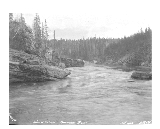
Omineca Gold Rush
Encyclopedia
The Omineca Gold Rush was a gold rush
in British Columbia
, Canada
in the Omineca region
of the Northern Interior of the province. Gold was first discovered there in 1861, but the rush didn't begin until late in 1869 with the discovery at Vital Creek
.
There were several routes to the goldfields: two were from Fort St. James, one of which was a water route through the Stuart
and Tachie Rivers to Trembleur Lake to Takla Lake
and the other was overland, called the Baldy Mountain route. A third route came in overland from Hazelton
on the Skeena River
and a fourth route used the Fraser River
and crossed over the Giscome Portage
to Summit Lake
, through McLeod Lake, and up the Finlay River
to the Omineca River
.
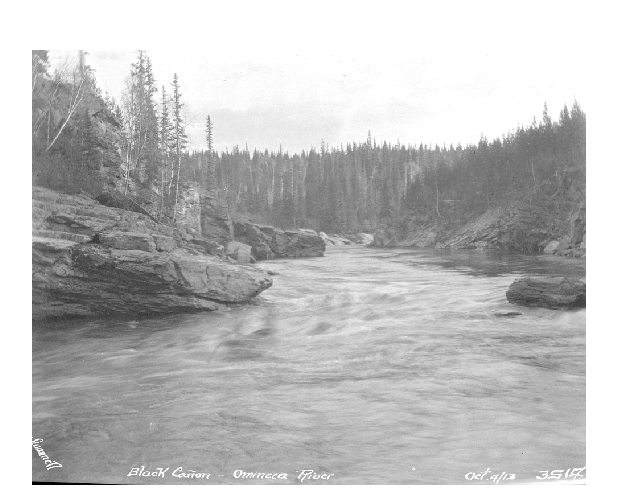 The first recorded gold discovery in the Omineca district was made by William Cust
The first recorded gold discovery in the Omineca district was made by William Cust
and Edward Cary in the summer of 1861. The two men had traveled up from Alexandria
that spring and returned in the fall with 60 ounces of gold between them. Despite such a small return for a summer filled with labor and hardship, they returned the following year with a group of more than twenty prospectors. In later years, some of these men would make major gold discoveries in the region, notably, Ezra Evans and Peter Toy. Along the Finlay River they discovered gold at a bar four miles from Finlay's Forks and named it Toy's Bar after Peter Toy. The bar would yield four ounces a day for each man. Another group of men on the Parsnip River
, discovered 60 ounces of gold.
Reports of these successes spread and in 1863, 150 men were in the area, among them, James May and the famous "Twelve-foot" Davis who had once made a small fortune by staking out a twelve foot section of ground between two rich claims. However, most of these newcomers were unsuccessful and, to make matters worse, supplies were scarce. Many prospectors had to leave the diggings and return to their homes in defeat. Two that stayed on and prospected at Toy's Bar were John Giscome and Henry McDame, both of whom had worked on the Peace
, Smoky
and Nation
Rivers. McDame had made a discovery in the Cassiar
district and McDame's Creek was named in his honor.
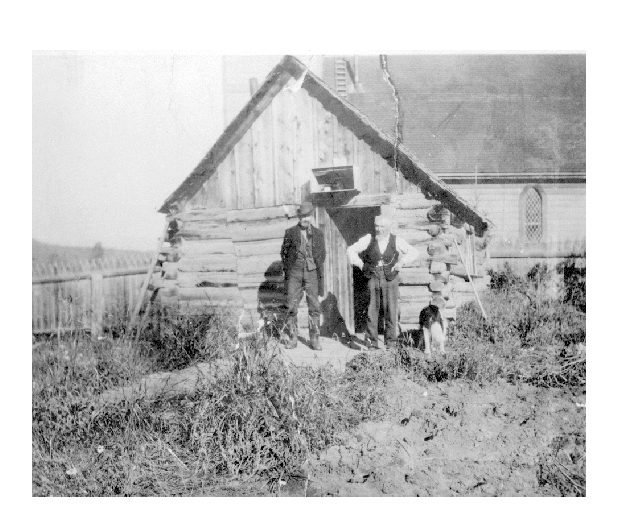 Throughout 1864-1868, very little activity is recorded in the Omineca district, although many of these prospectors returned regularly and worked at Toy's Bar and other known areas where they knew they'd find enough gold to be able to fund their other prospecting ventures.
Throughout 1864-1868, very little activity is recorded in the Omineca district, although many of these prospectors returned regularly and worked at Toy's Bar and other known areas where they knew they'd find enough gold to be able to fund their other prospecting ventures.
In 1868, four of the miners, Ezra Evans "Twelve-foot" Davis, William Humphrey and Gaylord went from Fort St. James up to Takla Landing via the Stuart, Trembleur and Takla Lakes. Along the way they discovered what they initially believed was silver
but was actually arquerite, an amalgam
of native silver and mercury
. They named the creek where they made this discovery Silver Creek. The four miners went back to Quesnel
that fall and appealed for funds to explore the Omineca area the following year. A group of miners was organized and after a concerted effort they raised more than $1000 from Quesnel farmers and businessmen and then the Colonial government gave the miners another $1000. The group of prospectors would be called the Peace River Prospecting Party. Strangely, the party was made up of only one of the original discoverers of Silver Creek, William Humphrey. The omission of Evans, Davis and Gaylord would be an error that the group's organizers would regret.
The rest of the group was Vital Laforce and Mike Byrnes, both of whom had been scouts for the Overland Telegraph Company
, along with Patrick Kelly, James Hawkins
and Allen Hawkins. The arrangements for the trip were made by a committee of three well-known men, storekeeper Peter Dunlevy who owned stores at Soda Creek
and Fort George
, Edgar Dewdney
and pioneer road builder Gustavus Blin-Wright who also owned the local paddle steamer
s, Enterprise
and Victoria
.
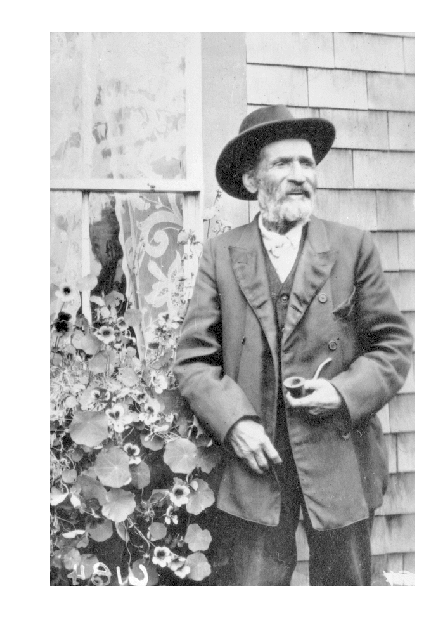 The Peace River Prospecting Party set out from Quesnel on May 3, 1869 having been supplied with a large boat, the necessary tools and a year's supply of food. The party followed the water route via the Fraser, Nechako and Stuart Rivers and up through Stuart, Trembleur and Takla Lake. When they arrived at Silver Creek, Vital Laforce discovered gold on one of its tributaries on June 21. In honor of this discovery the creek was named Vital Creek
The Peace River Prospecting Party set out from Quesnel on May 3, 1869 having been supplied with a large boat, the necessary tools and a year's supply of food. The party followed the water route via the Fraser, Nechako and Stuart Rivers and up through Stuart, Trembleur and Takla Lake. When they arrived at Silver Creek, Vital Laforce discovered gold on one of its tributaries on June 21. In honor of this discovery the creek was named Vital Creek
and the nearby mountains were named Vital Mountains.
The party received unexpected company near the end of June with the arrival of two of Silver Creek's original discoverers, Ezra Evans and Gaylord. Now the party had a problem, they had promised that they would simply explore and prospect, not actually work claims. Evans and Gaylord weren't bound by any such commitment and they moved upriver from the party and commenced mining. In retaliation the party stayed at Vital Creek and mined until freeze up.
One thing the two groups did agree on was that they wanted to discourage any more miners from coming up the following year. Though obliged to report their earnings, they all intended to report that the diggings were not very good and that more should be known of the country before any discoveries were reported. With the exception of Patrick Kelly and Vital LaForce, who stayed at Fort St. James, the other miners all returned to Quesnel with the news that the venture had only been marginally successful. However, suspicions were raised when the men announced they were returning to Vital Creek for the winter and even more eyebrows were raised when it was discovered that LaForce and Kelly had spent an astounding $2500 at the Fort St. James trading post.
On October 29 the Peace River Prospecting Party and Ezra Evans' group left to return to Vital Creek, but they would not be alone for long. Gold rush fever had swept Quesnel and letters had been sent to nearby Barkerville urging friends and family to drop everything and head for Omineca. Among these newcomers was Rufus Sylvester, who would not only mine in the Omineca district but would also run a letter and parcel express service between the Omineca diggings and Quesnel. Two other mining parties were organized, one under "Twelve-foot" Davis and another led by Duncan McMartin. Sylvester's party returned in December to record that they had staked 56 claims and they reported that the original miners at Vital Creek had been incorrect and the discovery was richer than everyone had been led to believe. Upon hearing this news, many more miners decided to go north to the Omineca diggings and the rush was officially on.
and Barnard's Express
. Each letter sent to or from the goldfields cost the sender a whopping $2.50.
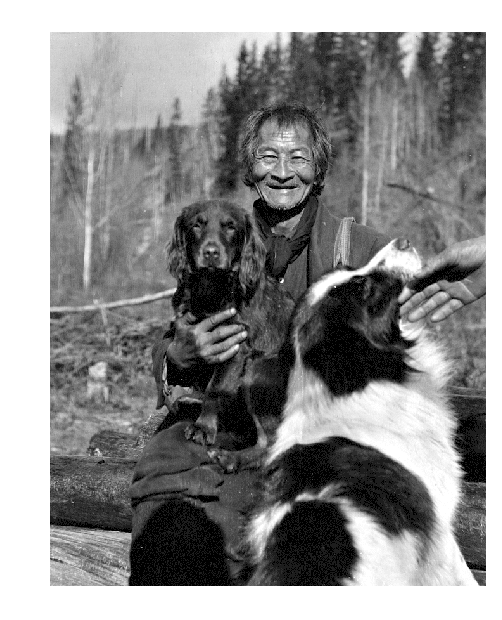 Lamont noted 250 new miners coming to the district that spring, and of that number he estimated that 60% of them were white, while the remaining 40% were experienced Chinese
Lamont noted 250 new miners coming to the district that spring, and of that number he estimated that 60% of them were white, while the remaining 40% were experienced Chinese
miners from the Cariboo
region.
The Quesnel Colonist reported that 350 men had passed through town on their way to the Omineca diggings.
Still others arrived on Captain William Moore's
barge
, which had left Quesnel at the end of April.
 A road was built from Takla Landing to Fall River under the direction of the newly installed Gold Commissioner
A road was built from Takla Landing to Fall River under the direction of the newly installed Gold Commissioner
, WH Fitzgerald. Road builder Gustavus Blin-Wright proposed the construction of a road over the ten mile stretch of land at Giscome Portage, and appealed to the government for the funds to do so. Wright also suggested that a cattle trail be built from Fort McLeod.
Later, in the spring of '71, Captain William Meade would bring in a pack train from Hazelton, and he would make many improvements on that trail. Despite the fact that these roads were built and improved during the rush years, the trip was still perilous and very costly. Steamer fare on the Fraser River on the Enterprise or the Victoria was $25 and 12.5 cents a pound was added for baggage. Smaller boats near the gold fields charged $7 for the ride and 7 cents a pound for baggage. At Takla Landing, yet more money was required, as that was a road toll
that charged 18 cents a pound for baggage.
 By June 1870, 400 men were in the Vital Creek area. A man named Gillis had built a saloon to serve the population and "Twelve-foot" Davis built a bakery and a coffee house.
By June 1870, 400 men were in the Vital Creek area. A man named Gillis had built a saloon to serve the population and "Twelve-foot" Davis built a bakery and a coffee house.
Despite these new amenities, many of the miners were disillusioned by the lack of new discoveries and left the area. The price of supplies dropped dramatically, which had a negative affect, as pack trains and boats no longer wanted to bring supplies into the area if they were going to make little or no profit on the venture.
The miners who stayed at Vital Creek soon heard of a new strike made by Pete Toy off the Omineca River. One of the parties who decided to go to those new diggings was led by an American
by the name of James Germansen. While he and his group were going to the new diggings, Germansen found an undiscovered creek coming off the Omineca River. To Germansen, this unknown creek, "seemed right", but his party was eager to get to Pete Toy's strike, so Germansen had to continue along with them. However when they arrived at Pete Toy's strike they encountered little success and returned to Vital Creek. But Germansen hadn't forgotten the little unnamed creek and he returned there with Duncan McMartin, James May and "Blackjack" Smith.
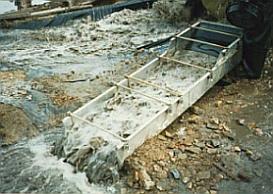 Germansen's instincts had been on the money. Each man in the party could easily pan
Germansen's instincts had been on the money. Each man in the party could easily pan
half an ounce to two ounces a day from Germansen Creek. The four men returned to Vital Creek in September with the good news and the migration from Vital Creek to Germansen Creek began. Rufus Sylvester constructed sluice boxes
and his group's yield was often ten ounces of gold per day for each man.
4400 ounces of gold were reported in 1870, but the real total may have been much higher as many of the miners were reluctant to reveal the true amount of gold taken from their claims.
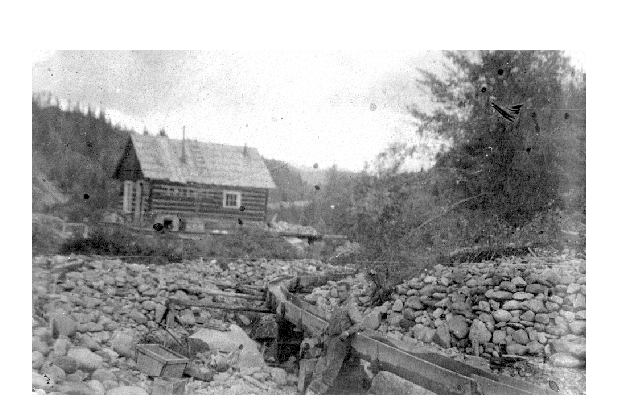 During the winter of 1870-71, Rufus Sylvester carried mails and gold between the Omineca district and Quesnel using a dog team. During this period a new settlement had been built at Germansen. Initially it was simply called Germansen, but it would later be called Omineca City. Another gold rush entrepreneur arrived in the area, Peter Cargotitch, and built a saloon at Omineca City and hired a group of entertainers called the McGinley Troupe to perform for his customers. At Germansen Creek, many good claims were being worked up and down both sides of the creek. One group of five men recovered 390 ounces in 13 days, while Duncan McMartin and his crew averaged 10 ounces a day and James Germansen and "Twelve-foot" Davis mined 20 to 120 ounces per week. Two sawmills were constructed, and sluice boxes were built by nearly all of the miners to aid in easier and faster gold retrieval. However, by June of '71, many of the miners at Germansen Creek were having little luck and they struck out to find new areas to prospect. On July 5, a man named Robert Howell made a discovery on Manson Creek, a small creek that was either named after Shetland Islander
During the winter of 1870-71, Rufus Sylvester carried mails and gold between the Omineca district and Quesnel using a dog team. During this period a new settlement had been built at Germansen. Initially it was simply called Germansen, but it would later be called Omineca City. Another gold rush entrepreneur arrived in the area, Peter Cargotitch, and built a saloon at Omineca City and hired a group of entertainers called the McGinley Troupe to perform for his customers. At Germansen Creek, many good claims were being worked up and down both sides of the creek. One group of five men recovered 390 ounces in 13 days, while Duncan McMartin and his crew averaged 10 ounces a day and James Germansen and "Twelve-foot" Davis mined 20 to 120 ounces per week. Two sawmills were constructed, and sluice boxes were built by nearly all of the miners to aid in easier and faster gold retrieval. However, by June of '71, many of the miners at Germansen Creek were having little luck and they struck out to find new areas to prospect. On July 5, a man named Robert Howell made a discovery on Manson Creek, a small creek that was either named after Shetland Islander
, William Manson
. or Donald Manson of the Hudson's Bay Company
.
 Robert Howell panned more than 20 ounces of gold in two hours. Manson's Creek was only eight miles from Germansen Landing and when the news of Howell's strike was made, men rushed to this new site and staked their claims. Whether it was named after him or not, William Manson would do very well at Manson Creek, and would return to the Shetland Islands, becoming a prominent businessman there and employing hundreds of his countrymen in mills he built for wool processing.
Robert Howell panned more than 20 ounces of gold in two hours. Manson's Creek was only eight miles from Germansen Landing and when the news of Howell's strike was made, men rushed to this new site and staked their claims. Whether it was named after him or not, William Manson would do very well at Manson Creek, and would return to the Shetland Islands, becoming a prominent businessman there and employing hundreds of his countrymen in mills he built for wool processing.
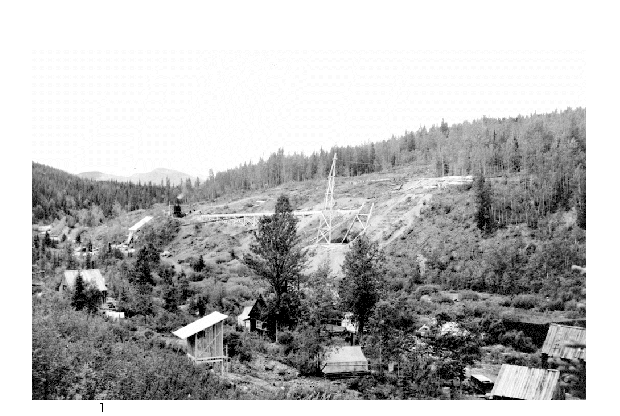 After the discovery at Manson's Creek in July of '71, more large strikes were made on nearby creeks. Among these were Blackjack Creek, Kildare Creek, Mosquito Creek, Slate Creek and Nugget Gulch. One of this richest creeks was found by accident by James Carson, H. Guest and J Griffith, who had gotten lost while looking for Manson's Creek and literally stumbled across it, thus they called it Lost Creek. The very first panful taken from Lost Creek yielded 3/4 of an ounce of gold. With all these new strikes in the district, new towns sprang up practically overnight: Manson's Creek, Howellton and Dunkeld. The residence of the Gold Commissioner's would be built at Dunkeld. There would be three Gold Commissioners for the Omineca district in the 1870s and they were, Peter O'Reilly
After the discovery at Manson's Creek in July of '71, more large strikes were made on nearby creeks. Among these were Blackjack Creek, Kildare Creek, Mosquito Creek, Slate Creek and Nugget Gulch. One of this richest creeks was found by accident by James Carson, H. Guest and J Griffith, who had gotten lost while looking for Manson's Creek and literally stumbled across it, thus they called it Lost Creek. The very first panful taken from Lost Creek yielded 3/4 of an ounce of gold. With all these new strikes in the district, new towns sprang up practically overnight: Manson's Creek, Howellton and Dunkeld. The residence of the Gold Commissioner's would be built at Dunkeld. There would be three Gold Commissioners for the Omineca district in the 1870s and they were, Peter O'Reilly
, WH Fitzgerald and D. Ballentyne, who would also act as Stipendary Magistrates.
Despite the building boom, there was only one trader in the area in the summer of '71, a man named Elmore who was stationed at Omineca City. Elmore made a small fortune selling supplies to the miners. Food prices were very high and some items, like picks and shovels weren't available at any price. Because of this high cost of living and the difficulty in procuring the necessary supplies, many miners left the area. Of those who stayed it is reported that some did vey well. One report claimed that 500 ounces a week was being taken from Germansen Creek alone. Again, these numbers may have been much higher, and very little was ever recorded on the Chinese miners, where they worked, or how they fared in their mining endeavours.
250 miners stayed in the region over the winter of 1871-'72 and constructed cabins at Howellton. A music hall was built at Dunkeld and another town was built at Manson's Creek, Manson's Town, which featured a music hall, theatre, recreation center and a bakery.
In the spring of 1873 Gold Commissioner WH Fitzgerald died of a seizure at his cabin in Dunkeld. By then rush was mostly over, even though there were still some claims that were doing well and Lost Creek was still yielding gold at the rate of 90 to 200 ounces a week. By the fall of that year, the news of the strike in the Cassiar district had reached the Omineca and many men left for these new, "greener pastures". Among those to go to Cassiar were Vital Laforce, Rufus Sylvester, "Blackjack" Smith and Henry McDame. James Germansen remained in the Omineca, while David Humphrey died from ingesting poisonous mushrooms.
80 miners were in the district in 1874 and the total reported gold they mined was 5000 ounces. In the Cassiar, 14,000 men produced 68,750 ounces. Therefore, if those estimates are correct, the ones who remained, fared better at 62.5 ounces per man, than the ones who left and made only 49.1 ounces per man.
and Ottawa
came to the district and began hydraulic mining
which continued well into the 1900s. The amount of activity fluctuated with gold prices, mining restrictions and economic conditions.
In the 21st century, mining is still being practiced in the Omineca, although all of the old gold rush towns are long gone, with the exception of Manson Creek, which still exists today.
Gold rush
A gold rush is a period of feverish migration of workers to an area that has had a dramatic discovery of gold. Major gold rushes took place in the 19th century in Australia, Brazil, Canada, South Africa, and the United States, while smaller gold rushes took place elsewhere.In the 19th and early...
in British Columbia
British Columbia
British Columbia is the westernmost of Canada's provinces and is known for its natural beauty, as reflected in its Latin motto, Splendor sine occasu . Its name was chosen by Queen Victoria in 1858...
, Canada
Canada
Canada is a North American country consisting of ten provinces and three territories. Located in the northern part of the continent, it extends from the Atlantic Ocean in the east to the Pacific Ocean in the west, and northward into the Arctic Ocean...
in the Omineca region
Omineca Country
The Omineca Country, also called the Omineca District or the Omineca, is a historical geographic region of the Northern Interior of British Columbia, roughly defined by the basin of the Omineca River but including areas to the south which allowed access to the region during the Omineca Gold Rush of...
of the Northern Interior of the province. Gold was first discovered there in 1861, but the rush didn't begin until late in 1869 with the discovery at Vital Creek
Vital Creek
Vital Creek is a creek located in the Omineca Country region of British Columbia. The creek is a tributary of Silver Creek and joins that creek from the west about 5 miles from its mouth. Vital Creek was discovered by Vital Laforce in 1869. This was the first creek mined in the Omineca. The...
.
There were several routes to the goldfields: two were from Fort St. James, one of which was a water route through the Stuart
Stuart River
The Stuart River is a river in northeastern British Columbia, Canada. The river flows over from Stuart Lake to its junction with the Nechako River. The river drains a portion of the Nechako Plateau — a gently-rolling region characterized by small lakes and tributaries...
and Tachie Rivers to Trembleur Lake to Takla Lake
Takla Lake
Takla Lake is the fifth largest natural lake in British Columbia, Canada. It is a deep fjord-like lake with the Swannell Ranges to the east, the Driftwood River flowing into it from the north, and the Middle River draining it. It is the terminus of the early Stuart-Takla sockeye salmon run, and...
and the other was overland, called the Baldy Mountain route. A third route came in overland from Hazelton
Hazelton, British Columbia
Hazelton is a small town located at the junction of the Bulkley and Skeena Rivers in northern British Columbia, Canada. It was founded in 1866 and has a population of 293...
on the Skeena River
Skeena River
The Skeena River is the second longest river entirely within British Columbia, Canada . The Skeena is an important transportation artery, particularly for the Tsimshian and the Gitxsan - whose names mean "inside the Skeena River" and "people of the Skeena River" respectively, and also during the...
and a fourth route used the Fraser River
Fraser River
The Fraser River is the longest river within British Columbia, Canada, rising at Fraser Pass near Mount Robson in the Rocky Mountains and flowing for , into the Strait of Georgia at the city of Vancouver. It is the tenth longest river in Canada...
and crossed over the Giscome Portage
Giscome Portage
The Giscome Portage was a portage between the Fraser River and Summit Lake in British Columbia, Canada. The south end of the portage is now the location of a heritage site, the Huble Homestead, which is located on the Fraser River, 40 km north of Prince George and 6 km off Highway...
to Summit Lake
Summit Lake Provincial Park
Summit Lake Provincial Park is a provincial park in British Columbia, Canada.Summit Lake Provincial Park is located on Highway 6, 13 km southwest of Nakusp at the height of land between Slocan Lake and Upper Arrow Lake...
, through McLeod Lake, and up the Finlay River
Finlay River
The Finlay River is a 402 km long river in north-central British Columbia flowing north and thence south from Thutade Lake in the Omineca Mountains to Williston Lake, the impounded waters of the Peace River formed by the completion of the W.A.C. Bennett Dam in 1968. Prior to this, the Finlay...
to the Omineca River
Omineca River
Omineca River is a river in northern British Columbia, Canada. It flows into the Williston Lake, and is part of the Peace River basin. It was originally a tributary of the Finlay River before the creation of Lake Williston.-References:...
.
Toy's Bar

William Cust
The Honourable William Cust , was a British barrister and Member of Parliament .Cust was a younger son of Brownlow Cust, 1st Baron Brownlow, by Frances, daughter of Sir Henry Bankes, of Wimbledon. John Cust, 1st Earl Brownlow, Peregrine Cust and Sir Edward Cust, 1st Baronet, were his brothers...
and Edward Cary in the summer of 1861. The two men had traveled up from Alexandria
Alexandria, British Columbia
Alexandria or Fort Alexandria is a National Historic Site of Canada on the Fraser River in British Columbia, and was the end of the Old Cariboo Road and the Cariboo Wagon Road...
that spring and returned in the fall with 60 ounces of gold between them. Despite such a small return for a summer filled with labor and hardship, they returned the following year with a group of more than twenty prospectors. In later years, some of these men would make major gold discoveries in the region, notably, Ezra Evans and Peter Toy. Along the Finlay River they discovered gold at a bar four miles from Finlay's Forks and named it Toy's Bar after Peter Toy. The bar would yield four ounces a day for each man. Another group of men on the Parsnip River
Parsnip River
The Parsnip River is a 240 km long river in central British Columbia, Canada. It flows generally north-westward from the Parsnip Glacier in the Hart Ranges to the Parsnip Reach of Williston Lake, formed by the impounding of the waters of the Peace River by the W.A.C. Bennett Dam in 1968...
, discovered 60 ounces of gold.
Reports of these successes spread and in 1863, 150 men were in the area, among them, James May and the famous "Twelve-foot" Davis who had once made a small fortune by staking out a twelve foot section of ground between two rich claims. However, most of these newcomers were unsuccessful and, to make matters worse, supplies were scarce. Many prospectors had to leave the diggings and return to their homes in defeat. Two that stayed on and prospected at Toy's Bar were John Giscome and Henry McDame, both of whom had worked on the Peace
Peace River (Canada)
The Peace River is a river in Canada that originates in the Rocky Mountains of northern British Columbia and flows to the northeast through northern Alberta. The Peace River flows into the Slave River, a tributary of the Mackenzie River. The Mackenzie is the 12th longest river in the world,...
, Smoky
Smoky River
Smoky River is a river in western Alberta, Canada. It is a major tributary of the Peace River. The descriptive name refers to the presence of "smouldering beds of coal in the riverbank" noted by the Cree Indians....
and Nation
Nation River
Nation River may refer to:* South Nation River in Ontario* Petite-Nation River in Quebec* Nation River , a tributary of the Peace River in British Columbia...
Rivers. McDame had made a discovery in the Cassiar
Cassiar, British Columbia
Cassiar is a ghost town in British Columbia, Canada. It was a small company-owned asbestos mining town located in the Cassiar Mountains of Northern British Columbia north of Dease Lake. After forty years of operation, starting in 1952, the mine was unexpectedly forced to close in 1992...
district and McDame's Creek was named in his honor.
Silver Creek

In 1868, four of the miners, Ezra Evans "Twelve-foot" Davis, William Humphrey and Gaylord went from Fort St. James up to Takla Landing via the Stuart, Trembleur and Takla Lakes. Along the way they discovered what they initially believed was silver
Silver
Silver is a metallic chemical element with the chemical symbol Ag and atomic number 47. A soft, white, lustrous transition metal, it has the highest electrical conductivity of any element and the highest thermal conductivity of any metal...
but was actually arquerite, an amalgam
Amalgam (chemistry)
An amalgam is a substance formed by the reaction of mercury with another metal. Almost all metals can form amalgams with mercury, notable exceptions being iron and platinum. Silver-mercury amalgams are important in dentistry, and gold-mercury amalgam is used in the extraction of gold from ore.The...
of native silver and mercury
Mercury (element)
Mercury is a chemical element with the symbol Hg and atomic number 80. It is also known as quicksilver or hydrargyrum...
. They named the creek where they made this discovery Silver Creek. The four miners went back to Quesnel
Quesnel, British Columbia
-Demographics:Quesnel had a population of 9,326 people in 2006, which was a decrease of 7.1% from the 2001 census count. The median household income in 2005 for Quesnel was $54,044, which is slightly above the British Columbia provincial average of $52,709....
that fall and appealed for funds to explore the Omineca area the following year. A group of miners was organized and after a concerted effort they raised more than $1000 from Quesnel farmers and businessmen and then the Colonial government gave the miners another $1000. The group of prospectors would be called the Peace River Prospecting Party. Strangely, the party was made up of only one of the original discoverers of Silver Creek, William Humphrey. The omission of Evans, Davis and Gaylord would be an error that the group's organizers would regret.
The rest of the group was Vital Laforce and Mike Byrnes, both of whom had been scouts for the Overland Telegraph Company
Overland Telegraph Company
In 1860, the Pacific Telegraph Act of 1860 called for the facilitation of communication between the east and west coasts of the United States of America. Hiram Sibley of the Western Union Telegraph Company won the contract. In 1861, Benjamin Franklin Ficklin joined Hiram Sibley in helping to form...
, along with Patrick Kelly, James Hawkins
James Hawkins
James Hawkins, from Maysville, Kentucky, was a Battlefield commissioned Second lieutenant and field operations leader of the United States Army Tiger Force commando unit, 1st Battalion , 327th Infantry Regiment, 1st Brigade , 101st Airborne Division, during the Vietnam War...
and Allen Hawkins. The arrangements for the trip were made by a committee of three well-known men, storekeeper Peter Dunlevy who owned stores at Soda Creek
Soda Creek
Soda Creek is a rural subdivision 38 km north of Williams Lakein British Columbia, Canada. Located on the east bank of the Fraser River, Soda Creek was originally the home of the Xat'sull First Nation. Soda Creek Indian Reserve No. 1 is located on the left bank of the Fraser River, one mile...
and Fort George
Prince George, British Columbia
Prince George, with a population of 71,030 , is the largest city in northern British Columbia, Canada, and is known as "BC's Northern Capital"...
, Edgar Dewdney
Edgar Dewdney
Edgar Dewdney, PC was a Canadian politician born in Devonshire, England. He served as Lieutenant Governor of the North-West Territories and the fifth Lieutenant Governor of British Columbia.-Early life and career:...
and pioneer road builder Gustavus Blin-Wright who also owned the local paddle steamer
Paddle steamer
A paddle steamer is a steamship or riverboat, powered by a steam engine, using paddle wheels to propel it through the water. In antiquity, Paddle wheelers followed the development of poles, oars and sails, where the first uses were wheelers driven by animals or humans...
s, Enterprise
Enterprise (1862)
The Enterprise was a passenger and freight sternwheeler that was built for service on the Soda Creek to Quesnel route on the upper Fraser River in British Columbia. It was built at Four Mile Creek near Alexandria by pioneer shipbuilder James Trahey of Victoria for Gustavus Blin-Wright and Captain...
and Victoria
Victoria (sternwheeler)
The Victoria sternwheeler was a passenger and freight steamer that was built for service on the Soda Creek to Quesnel route on the upper Fraser River in British Columbia....
.
Vital Creek

Vital Creek
Vital Creek is a creek located in the Omineca Country region of British Columbia. The creek is a tributary of Silver Creek and joins that creek from the west about 5 miles from its mouth. Vital Creek was discovered by Vital Laforce in 1869. This was the first creek mined in the Omineca. The...
and the nearby mountains were named Vital Mountains.
The party received unexpected company near the end of June with the arrival of two of Silver Creek's original discoverers, Ezra Evans and Gaylord. Now the party had a problem, they had promised that they would simply explore and prospect, not actually work claims. Evans and Gaylord weren't bound by any such commitment and they moved upriver from the party and commenced mining. In retaliation the party stayed at Vital Creek and mined until freeze up.
One thing the two groups did agree on was that they wanted to discourage any more miners from coming up the following year. Though obliged to report their earnings, they all intended to report that the diggings were not very good and that more should be known of the country before any discoveries were reported. With the exception of Patrick Kelly and Vital LaForce, who stayed at Fort St. James, the other miners all returned to Quesnel with the news that the venture had only been marginally successful. However, suspicions were raised when the men announced they were returning to Vital Creek for the winter and even more eyebrows were raised when it was discovered that LaForce and Kelly had spent an astounding $2500 at the Fort St. James trading post.
On October 29 the Peace River Prospecting Party and Ezra Evans' group left to return to Vital Creek, but they would not be alone for long. Gold rush fever had swept Quesnel and letters had been sent to nearby Barkerville urging friends and family to drop everything and head for Omineca. Among these newcomers was Rufus Sylvester, who would not only mine in the Omineca district but would also run a letter and parcel express service between the Omineca diggings and Quesnel. Two other mining parties were organized, one under "Twelve-foot" Davis and another led by Duncan McMartin. Sylvester's party returned in December to record that they had staked 56 claims and they reported that the original miners at Vital Creek had been incorrect and the discovery was richer than everyone had been led to believe. Upon hearing this news, many more miners decided to go north to the Omineca diggings and the rush was officially on.
1870s
In January of 1870, the Omineca region suffered very heavy snowfalls and extreme cold temperatures, and surface mining couldn't be performed. Shaft mining was attempted at various locations by Rufus Sylvester and Duncan McMartin, but both recovered insufficient gold and the shafts were abandoned.Omineca Express
That January RJ Lamont started the Omineca Express and delivered mail from Omineca to Quesnel using a dog team. His first round trip took him six weeks: he left Quesnel on January 31, arrived at Vital Creek and returned to Quesnel on March 16 with part of his hands and face frozen. Nevertheless, he continued this service throughout the spring and summer of 1870, handling the Omineca mail for Wells FargoWells Fargo
Wells Fargo & Company is an American multinational diversified financial services company with operations around the world. Wells Fargo is the fourth largest bank in the U.S. by assets and the largest bank by market capitalization. Wells Fargo is the second largest bank in deposits, home...
and Barnard's Express
Barnard's Express
Barnard's Express, later known as the British Columbia Express Company or BX, was a pioneer transportation company that served the Cariboo and Fraser Fort George regions in British Columbia, Canada from 1861 until 1921....
. Each letter sent to or from the goldfields cost the sender a whopping $2.50.

Overseas Chinese
Overseas Chinese are people of Chinese birth or descent who live outside the Greater China Area . People of partial Chinese ancestry living outside the Greater China Area may also consider themselves Overseas Chinese....
miners from the Cariboo
Cariboo
The Cariboo is an intermontane region of British Columbia along a plateau stretching from the Fraser Canyon to the Cariboo Mountains. The name is a reference to the woodland caribou that were once abundant in the region...
region.
The Quesnel Colonist reported that 350 men had passed through town on their way to the Omineca diggings.
Still others arrived on Captain William Moore's
William Moore (steamship captain)
William Moore was a steamship captain, businessman, miner and explorer in British Columbia and Alaska. During most of British Columbia's gold rushes Moore could be found at the center of activity, either providing transportation to the miners, working claims or delivering mail and...
barge
Barge
A barge is a flat-bottomed boat, built mainly for river and canal transport of heavy goods. Some barges are not self-propelled and need to be towed by tugboats or pushed by towboats...
, which had left Quesnel at the end of April.
New roads

Gold Commissioner
Gold Commissioner was an important regional administrative post in the Colony of British Columbia.In the 1860s, Governor Douglas had three priorities to protect the two colonies he governed: to protect the boundaries, to uphold law and order and to provide access to the gold fields...
, WH Fitzgerald. Road builder Gustavus Blin-Wright proposed the construction of a road over the ten mile stretch of land at Giscome Portage, and appealed to the government for the funds to do so. Wright also suggested that a cattle trail be built from Fort McLeod.
Later, in the spring of '71, Captain William Meade would bring in a pack train from Hazelton, and he would make many improvements on that trail. Despite the fact that these roads were built and improved during the rush years, the trip was still perilous and very costly. Steamer fare on the Fraser River on the Enterprise or the Victoria was $25 and 12.5 cents a pound was added for baggage. Smaller boats near the gold fields charged $7 for the ride and 7 cents a pound for baggage. At Takla Landing, yet more money was required, as that was a road toll
Toll road
A toll road is a privately or publicly built road for which a driver pays a toll for use. Structures for which tolls are charged include toll bridges and toll tunnels. Non-toll roads are financed using other sources of revenue, most typically fuel tax or general tax funds...
that charged 18 cents a pound for baggage.
Germansen Creek

Despite these new amenities, many of the miners were disillusioned by the lack of new discoveries and left the area. The price of supplies dropped dramatically, which had a negative affect, as pack trains and boats no longer wanted to bring supplies into the area if they were going to make little or no profit on the venture.
The miners who stayed at Vital Creek soon heard of a new strike made by Pete Toy off the Omineca River. One of the parties who decided to go to those new diggings was led by an American
United States
The United States of America is a federal constitutional republic comprising fifty states and a federal district...
by the name of James Germansen. While he and his group were going to the new diggings, Germansen found an undiscovered creek coming off the Omineca River. To Germansen, this unknown creek, "seemed right", but his party was eager to get to Pete Toy's strike, so Germansen had to continue along with them. However when they arrived at Pete Toy's strike they encountered little success and returned to Vital Creek. But Germansen hadn't forgotten the little unnamed creek and he returned there with Duncan McMartin, James May and "Blackjack" Smith.

Placer mining
Placer mining is the mining of alluvial deposits for minerals. This may be done by open-pit or by various surface excavating equipment or tunneling equipment....
half an ounce to two ounces a day from Germansen Creek. The four men returned to Vital Creek in September with the good news and the migration from Vital Creek to Germansen Creek began. Rufus Sylvester constructed sluice boxes
Placer mining
Placer mining is the mining of alluvial deposits for minerals. This may be done by open-pit or by various surface excavating equipment or tunneling equipment....
and his group's yield was often ten ounces of gold per day for each man.
4400 ounces of gold were reported in 1870, but the real total may have been much higher as many of the miners were reluctant to reveal the true amount of gold taken from their claims.
Manson Creek

Shetland Islands
Shetland is a subarctic archipelago of Scotland that lies north and east of mainland Great Britain. The islands lie some to the northeast of Orkney and southeast of the Faroe Islands and form part of the division between the Atlantic Ocean to the west and the North Sea to the east. The total...
, William Manson
William Manson
William Manson was a Scottish-born accountant, notary public and political figure in British Columbia, Canada. He represented Alberni from 1906 to 1907 and Skeena from 1909 to 1915 in the Legislative Assembly of British Columbia as a Conservative.He was born in the Shetland Islands, the son of...
. or Donald Manson of the Hudson's Bay Company
Hudson's Bay Company
The Hudson's Bay Company , abbreviated HBC, or "The Bay" is the oldest commercial corporation in North America and one of the oldest in the world. A fur trading business for much of its existence, today Hudson's Bay Company owns and operates retail stores throughout Canada...
.

Lost Creek and others

Peter O'Reilly
Peter O'Reilly was a prominent settler and official in the Colony of British Columbia, now a province of Canada who held a variety of positions, most notably as the head of a commission struck to revise and allocate Indian Reserves throughout the province.O'Reilly was criticized in his time and by...
, WH Fitzgerald and D. Ballentyne, who would also act as Stipendary Magistrates.
Despite the building boom, there was only one trader in the area in the summer of '71, a man named Elmore who was stationed at Omineca City. Elmore made a small fortune selling supplies to the miners. Food prices were very high and some items, like picks and shovels weren't available at any price. Because of this high cost of living and the difficulty in procuring the necessary supplies, many miners left the area. Of those who stayed it is reported that some did vey well. One report claimed that 500 ounces a week was being taken from Germansen Creek alone. Again, these numbers may have been much higher, and very little was ever recorded on the Chinese miners, where they worked, or how they fared in their mining endeavours.
250 miners stayed in the region over the winter of 1871-'72 and constructed cabins at Howellton. A music hall was built at Dunkeld and another town was built at Manson's Creek, Manson's Town, which featured a music hall, theatre, recreation center and a bakery.
In the spring of 1873 Gold Commissioner WH Fitzgerald died of a seizure at his cabin in Dunkeld. By then rush was mostly over, even though there were still some claims that were doing well and Lost Creek was still yielding gold at the rate of 90 to 200 ounces a week. By the fall of that year, the news of the strike in the Cassiar district had reached the Omineca and many men left for these new, "greener pastures". Among those to go to Cassiar were Vital Laforce, Rufus Sylvester, "Blackjack" Smith and Henry McDame. James Germansen remained in the Omineca, while David Humphrey died from ingesting poisonous mushrooms.
80 miners were in the district in 1874 and the total reported gold they mined was 5000 ounces. In the Cassiar, 14,000 men produced 68,750 ounces. Therefore, if those estimates are correct, the ones who remained, fared better at 62.5 ounces per man, than the ones who left and made only 49.1 ounces per man.
After the rush
Placer mining continued on a small scale in the Omineca for many years and then, in the 1890s large companies from VictoriaVictoria, British Columbia
Victoria is the capital city of British Columbia, Canada and is located on the southern tip of Vancouver Island off Canada's Pacific coast. The city has a population of about 78,000 within the metropolitan area of Greater Victoria, which has a population of 360,063, the 15th most populous Canadian...
and Ottawa
Ottawa
Ottawa is the capital of Canada, the second largest city in the Province of Ontario, and the fourth largest city in the country. The city is located on the south bank of the Ottawa River in the eastern portion of Southern Ontario...
came to the district and began hydraulic mining
Hydraulic mining
Hydraulic mining, or hydraulicking, is a form of mining that uses high-pressure jets of water to dislodge rock material or move sediment. In the placer mining of gold or tin, the resulting water-sediment slurry is directed through sluice boxes to remove the gold.-Precursor - ground...
which continued well into the 1900s. The amount of activity fluctuated with gold prices, mining restrictions and economic conditions.
In the 21st century, mining is still being practiced in the Omineca, although all of the old gold rush towns are long gone, with the exception of Manson Creek, which still exists today.
Chart of gold reported by year
| Year | Ounces Reported | Value in $ | No. of miners active |
|---|---|---|---|
| 1869 | None reported | ||
| 1870 | 4400 | ||
| 1871 | 31,000 | 400,000 | 1,200 |
| 1872 | 29,000 | ||
| 1873 | None reported | ||
| 1874 | 5000 | ||
| 1875 | 2002 | ||
| 1876 | None reported | ||
| 1877 | None reported | ||
| 1878 | None reported | ||
| 1879 | 2250 | ||
See also
- British Columbia Gold RushesBritish Columbia Gold RushesThe presence of gold in the region that is now British Columbia is mentioned in old legends that, in part, led to its discovery. The Strait of Anian, claimed to have been sailed by Juan de Fuca for whom today's Strait of Juan de Fuca is named, was described as passing through a land "rich in gold,...
- List of ghost towns in British Columbia
- Hazelton, British ColumbiaHazelton, British ColumbiaHazelton is a small town located at the junction of the Bulkley and Skeena Rivers in northern British Columbia, Canada. It was founded in 1866 and has a population of 293...

